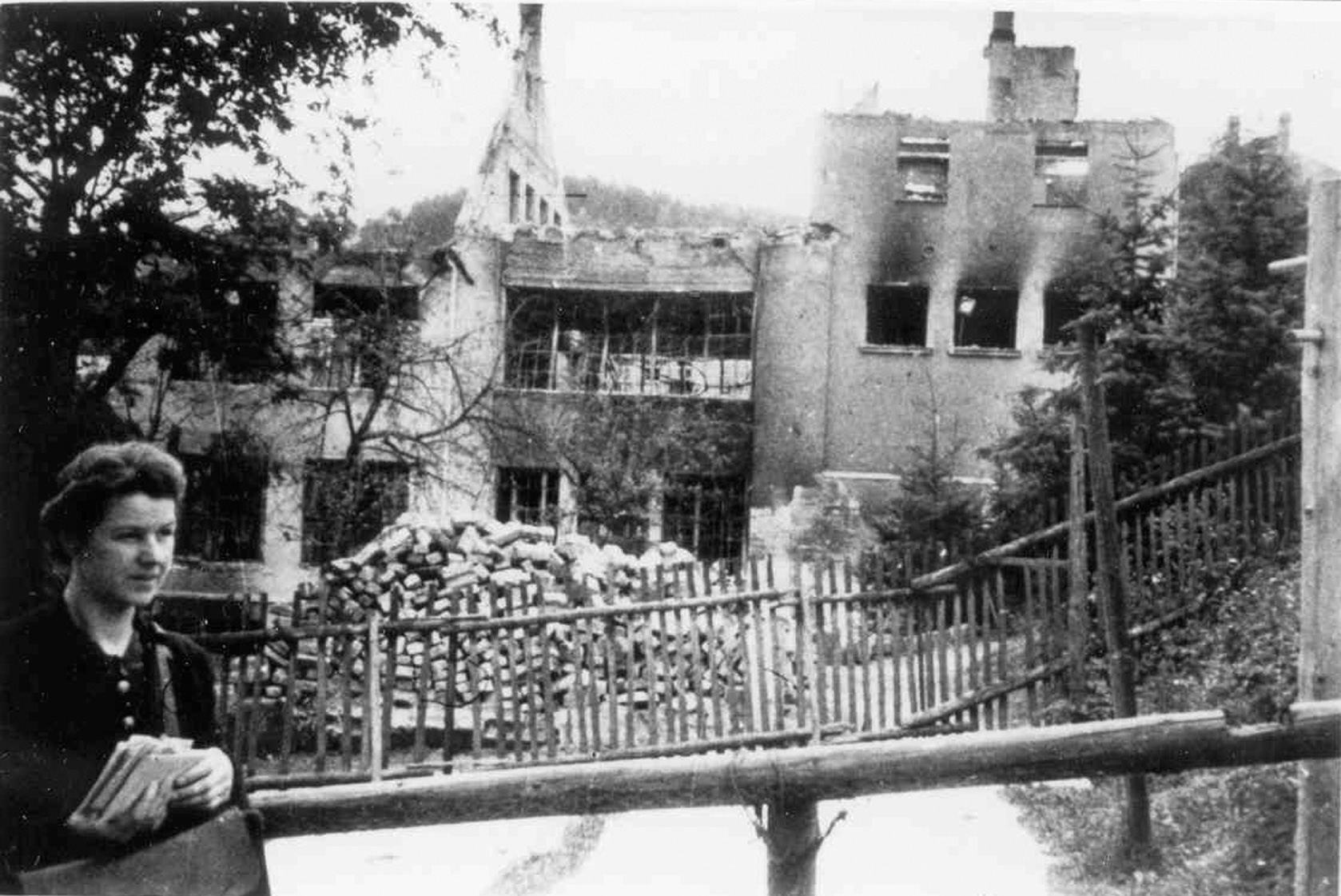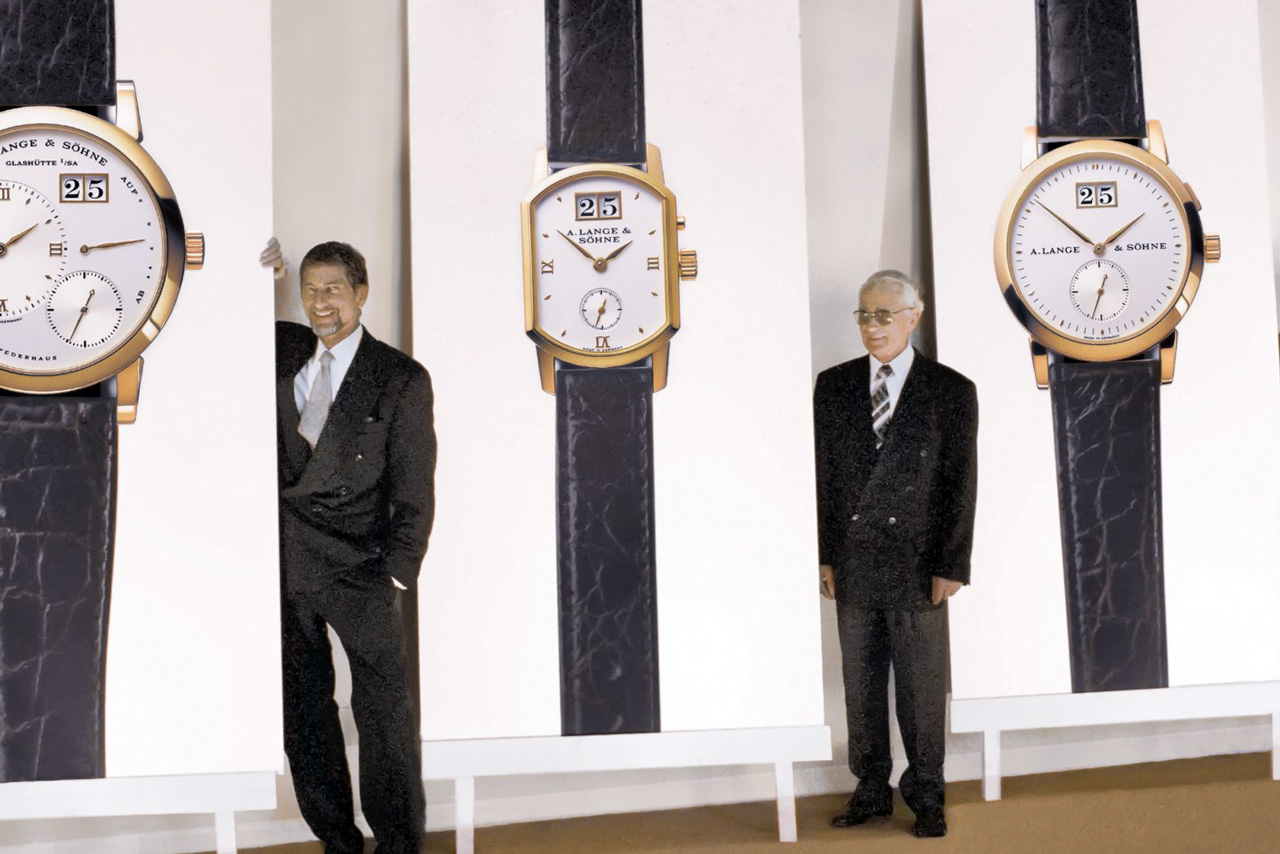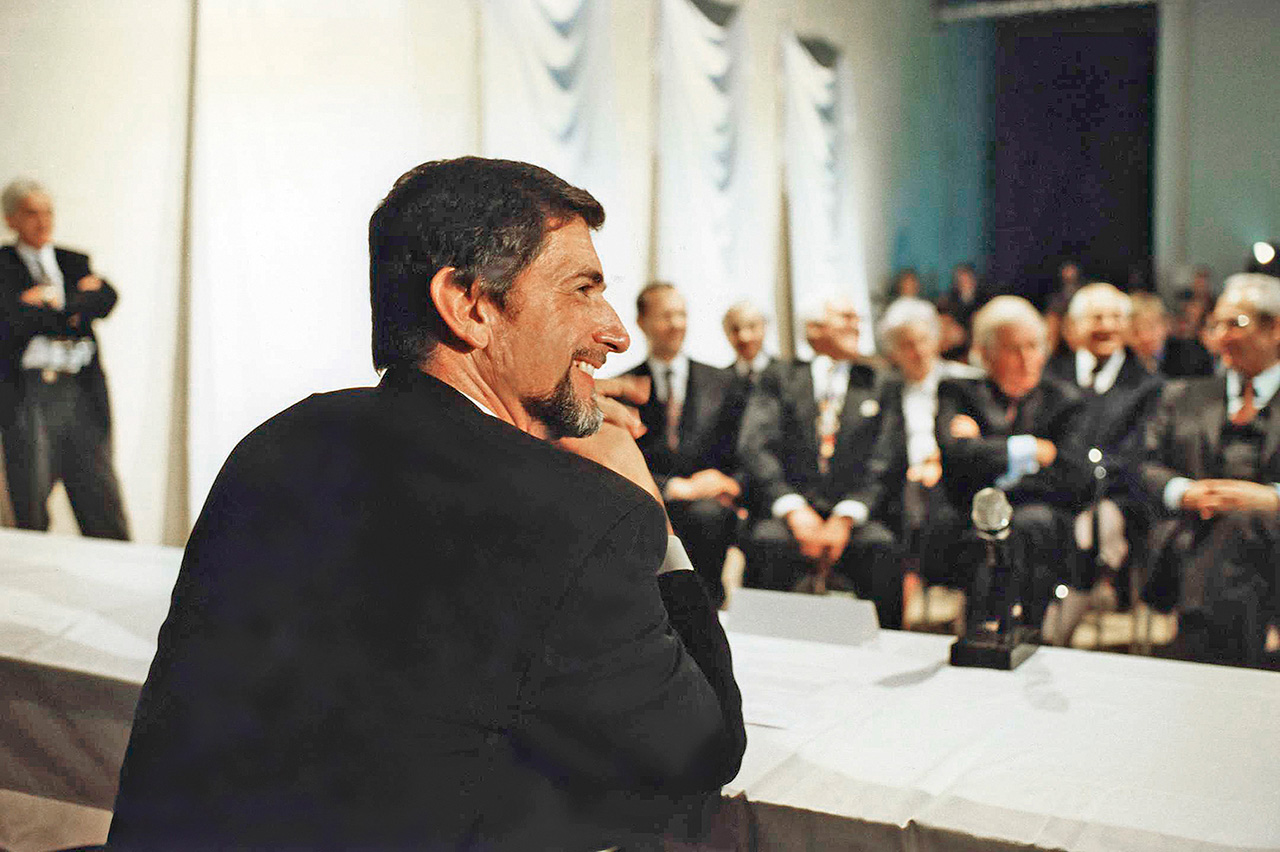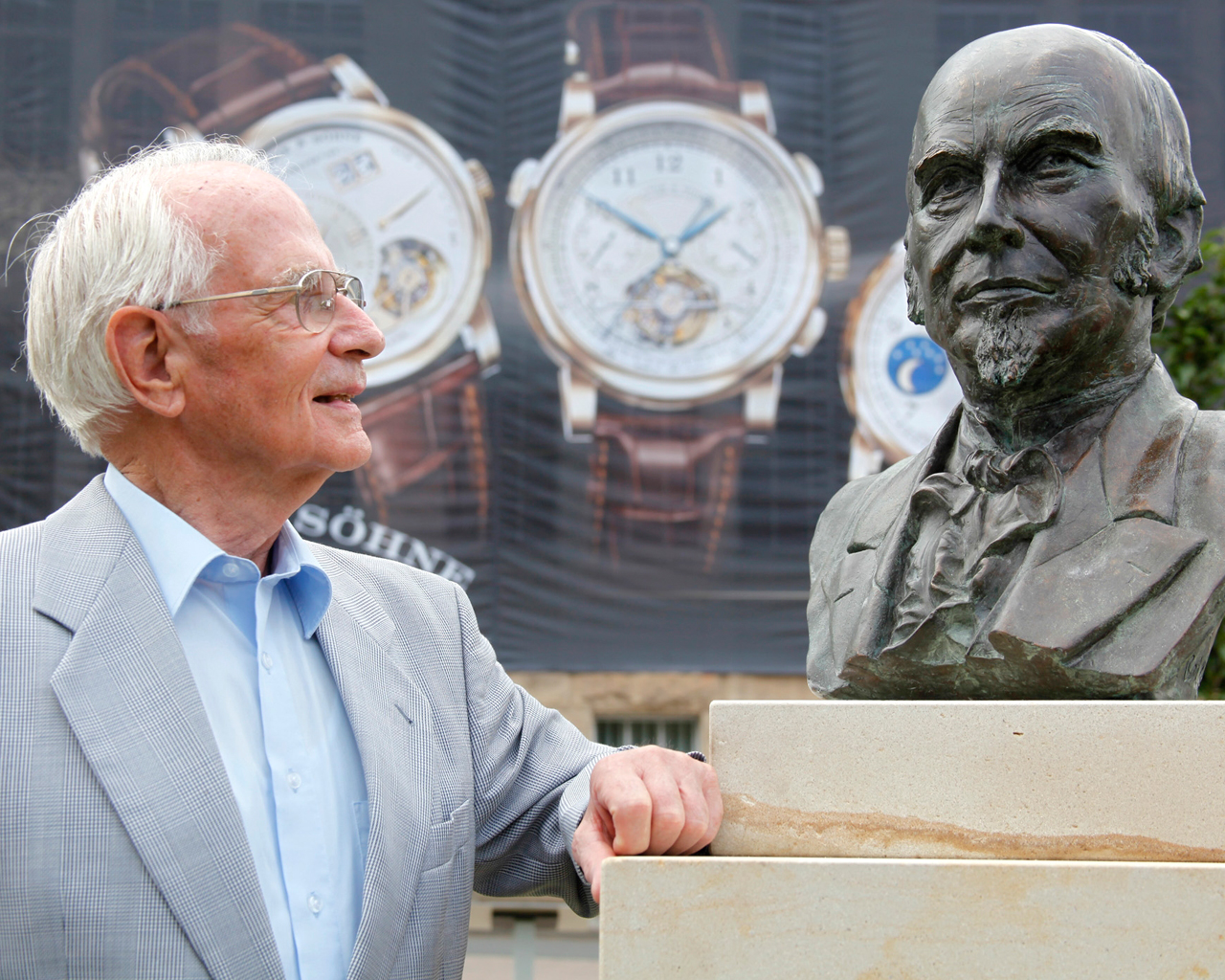Det beundrede tyske manufakturet A. Lange & Söhne bygger på en historie som strekker seg helt tilbake til 1845 og grunnlegger Ferdinand Adolph Lange.
Historien om dagens moderne A. Lange & Söhne skriver seg imidlertid til 1990, da merket startet ferden mot å gjenvinne gammel storhet med Walter Lange – oldesønnen til Ferdinand Adolph Lange – og den nå avdøde Günther Blümlein i spissen.
Denne måneden fyller Walter Lange 90 år, og Tidssonen har i den forbindelse fått tilgang til et sjeldent og eksklusivt intervju med jubilanten som vi har fått tillatelse til å gjengi i sin helhet:
Vita
On 29 July 2014, you will be celebrating your 90th birthday. A good reason to take review. What, would you say spontaneously, was the best time of your life?
ANNONSE
I’ll be honest: it was my childhood, even if that does sound rather mundane. I was carefree then; I didn’t have the worries of adulthood; there were little adventures to be had every day and I grew up in a very caring family. When I look back at my life, those are the best memories.
You were born into a family of watchmakers. When was your first encounter with timepieces?
Today, children play with remote-controlled cars or computers. When I was young, I had a watch kit. I can’t remember how old I was, but I assembled a watch with the pieces. As a child, I spent a lot of time in the manufactory; that had a big impact from the very beginning.

And then, you trained as a watchmaker yourself?
Yes, when I was 16, I followed the family tradition. At that time, only master courses were available in Glashütte, so I went to Karlstein in Austria. After one and a half years, I had to interrupt the apprenticeship because I was drafted into the army. After the war, I continued my apprenticeship with Alfred Helwig at the School of Watchmaking in Glashütte.
What was the worst time of your life?
It was a few hours during World War II after I had been wounded by a shot in the leg; I spent them lying completely still on the battlefield. I didn’t dare crawl out of the danger zone before nightfall. The war and all of the recollections associated with it haunt me to this day.
On the last day of the war, you witnessed the bombardment of the manufactory.
Yes, it was a terrible event. I had returned home via the Baltic Sea and ended up in a field hospital near Glashütte where my leg injury was treated. It was a fortunate circumstance, a stroke of luck if you will.

My father secured a leave of absence for me, issued for the period from 7 to 15 May 1945. I was incredibly happy to finally be with my family again. But on 8 May, in the morning, the bomb alarm went off and our main production building was destroyed in a bombing raid.
The watchmaking companies in Glashütte were expropriated after the war. How did you experience that period?
At that time, my father Rudolf and his two brothers Otto and Gerhard ran the manufactory. Of course, we tried to keep working and rebuild the production facility. I had extensive discussions with my father and uncle Otto regarding the future of the company. We began to develop the calibre 28 for a wristwatch, but before it went into series production, the company was expropriated – in April 1948. My father and his brothers were no longer allowed to set foot in the manufactory. I was asked to join the union, but refused. Subsequently, I avoided forced labour in a uranium mine by fleeing from my hometown one night in November 1948.
After its expropriation in 1948, the company became a publicly-owned operation and was merged with other watchmaking businesses in Glashütte in 1951. The A. Lange & Söhne brand was no longer used. You went to Pforzheim. How did you experience the situation from afar?
With great concern. I was worried mainly about my father, who was devastated by the expropriation. He came to live with us in Pforzheim, but he could not cope with the loss of the manufactory and his home. He passed away less than a year later. We all assumed that the family business had been lost forever, and we were heartbroken.
You had the courage to restart the business in Glashütte on 7 December 1990. Was that difficult?
It was a risk, but the only way for me to go. When the Berlin Wall fell, I had already retired. But I simply couldn’t pass up the opportunity to revive the heritage of my ancestors. The 7th of December 1990 was among the greatest days of my life. I reregistered the brand using the borrowed address of a former classmate at our primary school in Glashütte. We had to start completely from scratch.
What happened next?
During the first weeks and months we had to overcome many obstacles. There’s one story that I still vividly remember. In 1990/1991, we negotiated the return of the confiscated Lange family domain with the Treuhand trust agency. On Wednesday before Easter, I met with Treuhand Chairman Detlev Karsten Rohwedder and after our conversation finally had the feeling that I was talking to the right person. Five days later, on Easter Monday in the evening, Rohwedder was shot in his home. I was stunned. The continued negotiations with Treuhand concerning the return of the property were unsuccessful. It wasn’t until the year 2000 that we were able to repurchase the building from the city of Glashütte.
Who was your most important confidant?
My partner Günter Blümlein. Without him, the revival would certainly have been impossible. Blümlein was a man of deeds and a visionary. His thinking was long-term. He was an excellent strategist and had a knack for watch design and effective marketing.

How close were you?
Günter Blümlein and I spent a lot of time together after the reunification of Germany. We often sat together over a glass of red wine at the Ladenmühle, a small hotel near Glashütte. He always wanted me to tell him about the old days, about my ancestors’ pocket watch manufactory. Those were wonderful evenings that I fondly remember. Later, we regretted the fact that we didn’t tape our conversations with a dictating machine.

The days prior to the presentation of our first collection in October 1994 were particularly exciting. At that time, Blümlein and I shared an office. We sat in front of our typewriters and together, we discussed the content of our speeches for the first press conference. It is tragic that Blümlein passed away at such a young age.
Can you summarise your vision for the renaissance?
From the outset, we wanted to develop watches that were sleek and classic in appearance but very modern at the same time.

When you started out with a staff of 15, did you ever think that A. Lange & Söhne might again become a company of global stature?
That, of course, is what we were hoping. After all, my forefathers were internationally successful with their pocket watches. Owners of historic Lange timepieces from all over the world still contact us today. Initially, we wanted to sell our new watches in Germany and elsewhere in Europe. But enquiries soon reached us from overseas. I am delighted that we succeeded in repositioning A. Lange & Söhne on the international stage.
What was the highlight of your career?
That’s difficult to pinpoint. The successful press conference on 24 October 1994, when we presented our first collection, was one of them. There was another moment like that in 2013, too, when we first exhibited our GRAND COMPLICATION – a limited edition of six pieces – in Geneva. At that point, I again had the feeling that Lange was doing everything right. I felt proud of the tradition, the company and its staff.
And what delights you most?
The results that have been attained from such modest beginnings. Lange didn’t remain the only company in Glashütte. In the meantime, Glashütte has become the centre of the German watch industry again. Over 1300 people have found jobs here and transformed the region into a “flourishing landscape”. Of course, I’m pleased with the role that A. Lange & Söhne has played in this process. As was the case during my great-grandfather’s era, Lange is the region’s driving force. I believe most people see it like that.
A saying goes: No success without failure. What was your most bitter one?
For me, the 1948 expropriation ranks among my bitterest experiences. But it was even worse to have to witness the gradual downfall of the nationalised manufactory. The first apprentice still works at Lange today. Are you on first-name terms? In 1997, we began to train two watchmakers. One of them is still with the company. Today, he belongs to the product development team and contributes to the design of new calibres. He is a rather reserved young man. I believe that to him, I’m simply “Herr Lange”, as for everyone else.
What do you like about the Glashütte townsfolk?
I like their calm and composure, which probably annoys people from the city. But then, perfection doesn’t go well with speed.
Achievement
What are the characteristics of a typical Lange watch?
Günter Blümlein once said that a Lange watch is a fusion of the arts, consisting of a proud legacy, the passion of our staff for fine timepieces, the style of the company, a responsibility for its traditions, and finally the unique technology and artisanship to which we are committed. I can only agree.
How often are you asked about your name? Are you comfortable with it?
Fortunately, Lange is a common name. Outside horological circles, I am only rarely confronted with questions about it. To me, it primarily stands for responsibility. And that is less associated with the name itself than with family traditions, the enterprise, the town of Glashütte and the people who live and work here. As a child, I saw mass unemployment in the 1920s and 1930s, and I realised how much my parents feared having to let employees go. That influenced my thinking. It was an important reason for re-establishing our manufactory. When the Berlin Wall fell, my first concern was not to revive the name A. Lange & Söhne; my main concern was to make a contribution to giving the people of Glashütte a fresh perspective. I wanted to bring jobs back to Glashütte.
Mr. Lange, can you still count your achievement awards?
I don’t really have that many. In July 1998, I received the Medal of Merit of the Free State of Saxony. I have also been a proud honorary citizen of Glashütte since 1995. I was particularly pleased about the “Hommage à la Passion” award for my lifework, presented to me last year by the FHH – the Fondation de la Haute Horlogerie – in Lausanne. In Switzerland of all places!
For which accomplishment in your life would you give yourself an award?
Ah, others should do that. I am grateful for all the luck I’ve had in the course of my life. Sometimes I think: “Fate has spared me for Glashütte.” Without the renaissance of Lange, Glashütte would look very different today. I am happy to have made a contribution toward reviving the watch industry in our Ore Mountains community. It’s wonderful to see so many people crafting watches in Glashütte. That makes me happy.
What’s your vision for the future of the company?
I am no longer involved in the daily business. But I still attend important events. As long as our watchmakers strive to craft the world’s best watches, the brand will be heading in the right direction. We cannot lower our in-house standards: quality is what makes Lange. It must stay that way.
Passion
You have travelled extensively. Which place impressed you most?
I have visited many countries and felt at ease in many locations. The pyramids of Giza in Egypt were particularly impressive. To stand there in front of those gigantic structures, knowing that Cleopatra stood there 2000 years ago and they looked exactly the same then as they do now… the dimensions are unimaginable. The ancient cities of the Mayas in Mexico deeply impressed me as well. Or take a look at the Green Vault in Dresden with its works of art in ivory, amber and silver. When you think of what people accomplished at the time, without the benefits of modern technology, using just simple tools – that fascinates me immensely.
And Glashütte? How do you like the city today?
Glashütte is lovely now. No matter where you look: the town’s blemishes have disappeared, which makes me happy. Just last April, I was on the mountain near the observatory. There’s a bench that gives you a wonderful view of the town. A photograph that dates back to my childhood shows my father with me and my siblings sitting on that bench. We were there often in those days to enjoy a picnic and bask in the sun. After all, there’s more sun up there than down in the valley.
Which personalities have left the most lasting impression on you?
My father was always a role model and mentor for me. My uncle Otto was another important person in my life as regards the art of watchmaking. When I was a child, he often took me to the workshops and showed me many things.
Your biggest strength?
Perhaps my stubbornness. Had I given up hope of reviving the old traditions, I would have stayed an ordinary retiree in 1990. But for me, at 66, a new chapter of my life began. It’s still the same today: if something is important to me, I support it with all my energy. I tell people what I like – and also what I don’t like, which doesn’t always go down well with those involved. But that’s acceptable at my age and with my experience, I think.
Do you remember your first watch?
Yes, it was a Cyma wristwatch. It wasn’t until my confirmation that I received a Lange watch. It was an OLIW. The abbreviation stands for “Original Lange Internationales Werk”. Launched in the 1920s, it was the more affordable line of A. Lange & Söhne. How many watches do you own personally and which one is your favourite? It’s a manageable number. Being a watchmaker, I have a weakness for technical complications. That’s why I like to wear the Tourbillon “Pour le Mérite” from the first collection, also because this watch is a reminder of the revival of the A. Lange & Söhne brand.

Which other watch brands do you admire?
I love the pendulum clocks made by Erwin Sattler in Munich. I once had a set of parts for such a clock and assembled it myself. That was a real joy. The clock is still on the wall in my house.
What else, apart from timepieces, arouses your enthusiasm?
I have a fondness for vintage cars. I vividly remember my rear-engined Fiat 600. My wife and I drove up the Brenner pass with it. I honked the horn all the way up because I had to keep the accelerator pressed. People along the road jumped aside to make way for us. Or my Horex 350 motorcycle with the wonderful sound. My wife would sit in the sidecar. We had wonderful day trips with it. Two years ago, I drove my Mercedes convertible to the Concorso d’Eleganza on Lake Como. Its three-litre engine hummed, it was bliss. My heart beat faster when I arrived in Como and saw so many incredible classic cars in one place!
What piece of advice would you give young people today?
Each generation should discover its own path. One thing, perhaps: in my opinion, there’s too much complaining these days. Everyone is stressed, nothing is just right. The conditions were totally different when I was young. For a trip to Dresden, my mother would pack a few boiled potatoes as provisions, that was all. Or the years after the war: initially, a meal consisted of a water soup with grated potatoes, a so-called “Zudelsuppe”. A year later, it contained salted carrots from the backyard garden. We were satisfied with what we had. I would wish that today’s youngsters could feel the same way more often.
Birthday
You are turning 90. Can you give us your recipe for a long life?
On weekends, I often went out into the countryside. Away from the city, I would stretch my legs, enjoy the beautiful landscape and breathe fresh air. It felt good to recharge my batteries that way. Today, I try to go for a walk at least once a day. There’s another even more important aspect: positive thinking as a habit. The news is dominated by negative headlines. That’s depressing. We should shift the focus on the pleasant things in life. People like me who experienced the global economic crisis in 1929 and World War II know how wonderful life can be today. Positive thinking. It means doing what you really want and looking to the future with courage and enthusiasm. For me, those are the keys to a long life.

How are you these days?
I’m as well as a person at my age can be. Sure, I occasionally feel pinches here and there, but overall, I’m still in good shape. For that I am very grateful.
What happens on a typical day in your current life?
That depends. When I’m at home, the days are not very exciting, of course. I read, make phone calls, spend time in the garden. When I’m travelling, my schedule is determined by the events that I am attending, whether interviews are planned, or a dinner in the evening. In Glashütte, I like to visit the ateliers of our watchmakers. No matter where I am, I always try to take a nap after lunch. It’s relaxing and provides vigour for the second half of the day.
What will you do on your birthday?
I haven’t made any definitive plans. We’re not quite there yet. At any rate, I will be together with my family and closest friends on my birthday. Later on, in August, we will have a little party with Lange staff members.
What’s the nicest birthday present you ever received?
That is difficult to say. I have received quite a few that mean a lot to me. Wonderful gifts were given to me by customers, collectors of long standing. A closer look reveals the affection with which they were made and the thought that inspired the giver’s choice. I really appreciate these presents. They are displayed on the sideboard in my Glashütte office and delight me every time I’m there.
What is your personal wish for your 90th birthday? Which dreams would you like to see come true?
Good health is my only wish. Otherwise, I’m happy in every respect.
ANNONSE

















